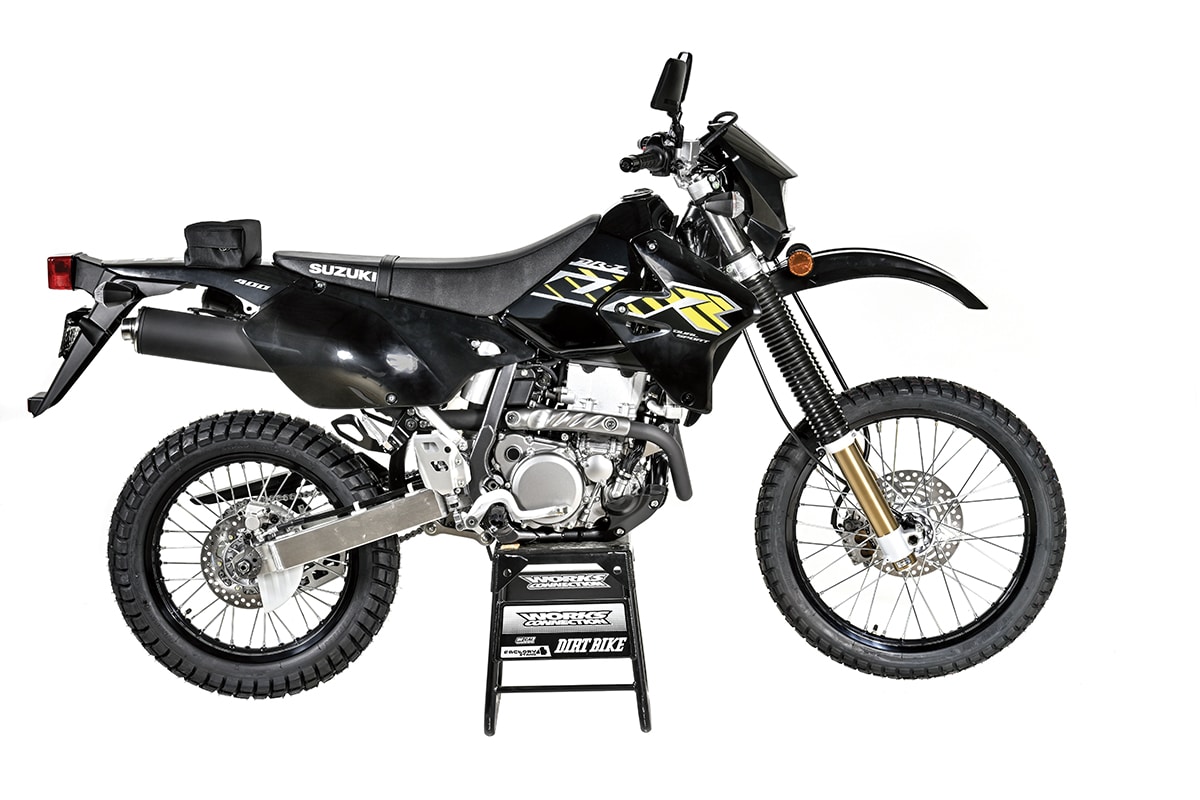Ken Roczen was 6 years old when the Suzuki DR-Z400S was first released. It was the year 2000, and the motorcycle world was about to go through some dramatic changes. Four-strokes would soon dominate the market, and most Japanese two-strokes would go out of production. If any bike had perfect timing, it was that first DR-Z. Today, it’s still Japan’s second-best dual-sport bike in stock form. It was, in fact, the best of its kind until 2019 when Honda released the CRF450L. Now, the Suzuki sells for $7099, which is about $3000 less than the Honda. There’s no dual-sport bike on the market that offers so much for so little.
AS TIMES CHANGE
Yes, the DR-Z was designed in a different era, but if it were built today, it wouldn’t be that different. The carburetor would have to go, of course. But, the motor is a compact, double-overhead-cam four-valver with electric start and a counterbalancer. About the only difference between the layout of this motor and that of most modern four-stroke motocross bikes is that it doesn’t use finger-followers in the drivetrain. The DR-Z uses a shim and buckets to drive the valves directly. There are a few other old-school design elements. It still has what we used to call a “right-side up” fork. It has a steel tank, a steel frame and a steel handlebar. Think back to when this bike arrived. At the time, there was no Honda CRF450R, and no serious motocross four-strokes from Suzuki or Kawasaki, so the DR-Z acted as the Suzuki off-road race team’s primary weapon out west. Mike Kiedrowski won back-to-back WORCS championships in 2001 and 2002 on a Yoshimura-built DR-Z against a field of Yamaha 426s.
Today, you have to dig pretty deep to find Kiedrowski’s DR-Z in the dualsport version. It’s still in there, but you would have to spend a lot to reach the level of a modern 450—and it’s probably still not possible. It would be kind of funny, though, to show up with the only electric-start Suzuki at a local motocross. In stock form, performance is decent. It makes only 2 horsepower less than a Husqvarna FE350S at peak and does better down low. Of course, a stock Husky FE isn’t a very high bar, but it’s easy to find cheap power. The first stop is a Keihin FCR carburetor. That was what the dirt version of this bike came with. You can find them easily on the used market, and the air boot and manifold from the dirt version make this an easy conversion. The standard unit on the dual-sport version is a 36mm Mikuni CV carb, which is okay on the street but can’t deal with rough terrain. It uses a floating piston and a diaphragm that bounces around and can deliver erratic performance.
BIG GIRL
A more serious limitation in the dirt is that the Suzuki weighs over 300 pounds, and there’s very little you can do about that without spending a fortune. There’s no way that Kiedrowski was racing a 300-pound bike, but the Suzuki off-road team probably has a bigger budget than you do. After you replace the pipe, the fuel tank and strip off superfluous items, you might shave off 20 pounds. The main appeal of the Suzuki is the low price, so it would be silly to go much further than that.
It’s better to just keep your perspective. This isn’t a bike for competition anymore. It’s excellent for casual trail rides—and it’s more effective than you might think. The biggest limitation is the stock Bridgestone Trail Wing tires, which are very street-oriented. There’s a wide assortment of aftermarket DOT approved full knobbies that offer better performance, but you also need to understand that they don’t provide the wear of the stockers. If you ride mostly pavement, you will be lucky to go 25 percent as far before it’s time for new rubber. Even though it sounds expensive, you might consider an extra set of wheels with knobbies set aside for special occasions. The nice thing about a bike that has been on the market for 23 years is that there are plenty of used parts to be had, and that certainly includes wheels.
With decent tires, the Suzuki has no trouble keeping up with more modern dual-sport bikes on moderately difficult singletrack. The Suzuki’s handling and suspension are surprisingly good, and the ergos are almost modern feeling—definitely more up to date than a Honda XR650L or a Suzuki DR650. It feels so normal, in fact, that you could easily get carried away. In the end, the weight will make its presence known on a steep downhill or in a tight turn, and you won’t make that mistake again.
One aspect of the Suzuki that’s far superior to any of its more expensive competitors is comfort. The DR-Z is in a different league. The seat is cushy, and the motor is almost vibration-free. On that last point, a big factor is the fact that you ride the Suzuki at a much lower rpm level than you would a KTM, Beta or Husky 350. All of those bikes are revvers, whereas the Suzuki likes to be ridden at lower and middle rpm levels.
A CLASS APART
Right now there’s nothing quite like the Suzuki DR-Z400S. It exists in a gap between new-wave dual-sport bikes that sell for thousands more and mainland Asian bikes that were never made with any level of off-road performance in mind. The Suzuki has a heritage of performance and success. And, while it might not have the status it once did, it still has a great deal to offer and might continue for another 23 years.








Comments are closed.